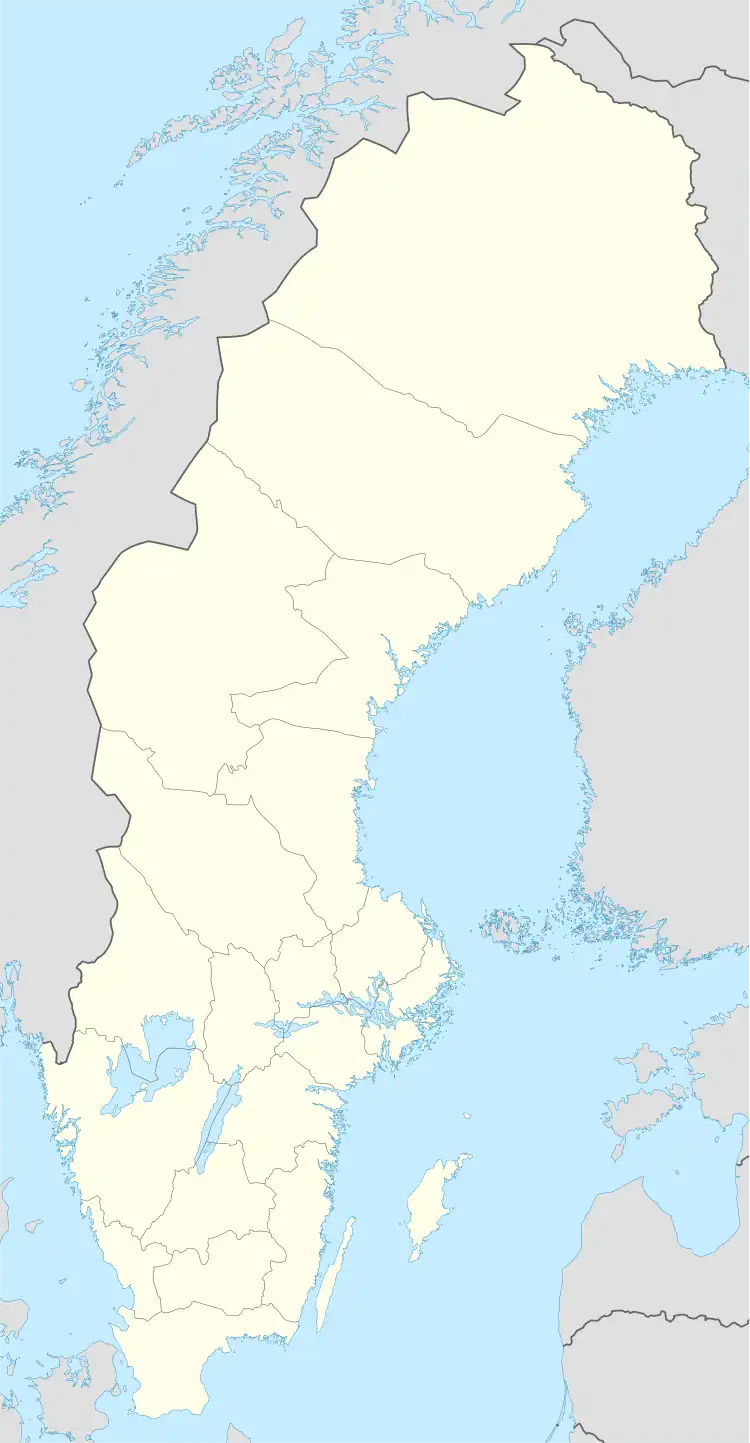| Europamästerskapet i fotboll Sverige 1992 | |
|---|---|
 Small is Beautiful | |
| Tournament details | |
| Host country | Sweden |
| Dates | 10–26 June |
| Teams | 8 |
| Venue(s) | 4 (in 4 host cities) |
| Final positions | |
| Champions | |
| Runners-up | |
| Tournament statistics | |
| Matches played | 15 |
| Goals scored | 32 (2.13 per match) |
| Attendance | 430,111 (28,674 per match) |
| Top scorer(s) | (3 goals each) |
The 1992 UEFA European Football Championship was hosted by Sweden between 10 and 26 June 1992. It was the ninth UEFA European Championship, which is held every four years and supported by UEFA.
Denmark won the 1992 championship, having qualified only after Yugoslavia was disqualified as a result of the breakup of the country and the ensuing warfare there. Eight national teams contested the final tournament.[1]
The CIS national football team (Commonwealth of Independent States), representing the recently dissolved Soviet Union, whose national team had qualified for the tournament, were present at the tournament. It was also the first major tournament in which the reunified Germany (who were beaten 2–0 by Denmark in the final) had competed.
It was the last tournament with only eight participants, to award the winner of a match with only two points, and before the introduction of the back-pass rule, the latter of which was brought in immediately after the tournament was completed. When the next competition was held in 1996, 16 teams were involved and were awarded three points for a win.
Bid process
On 16 December 1988, following a decision made by the UEFA Executive Committee, Sweden was chosen over Spain to host the event.[2] Spain was at a disadvantage as they had already been chosen to host the EXPO 1992 in Seville and the 1992 Summer Olympics in Barcelona.[2][3]
Summary
Seven of the eight teams had to qualify for the final stage; Sweden qualified automatically as hosts of the event.[4] The Soviet Union qualified for the final tournament shortly before the break-up of the country, and took part in the tournament under the banner of the Commonwealth of Independent States (CIS),[5] before the former Soviet republics formed their own national teams after the competition. The CIS team represented the following former Soviet nations: Russia, Ukraine, Belarus, Kazakhstan, Uzbekistan, Turkmenistan, Kyrgyzstan, Armenia, Azerbaijan, Moldova, and Tajikistan. Four out of 15 ex-republics were not members of the CIS: Estonia, Latvia and Lithuania did not send their players; Georgia was not a member of the CIS at the time, but Georgian Kakhaber Tskhadadze was a part of the squad.
Originally, Yugoslavia qualified for the final stage and were about to participate as FR Yugoslavia, but due to the Yugoslav Wars, the team was disqualified and Denmark, as the runners-up from Yugoslavia's qualifying group, was invited to take part instead.[6] After a draw with England and a loss to host nation Sweden, Denmark beat France in their final group match to qualify for the semi-finals, where they would face the reigning European champions, the Netherlands. Denmark led 2–1 going into the last five minutes, but a Frank Rijkaard equaliser meant the game went to a penalty shoot-out; Danish goalkeeper Peter Schmeichel saved Marco van Basten's kick, giving Denmark a 5–4 win on penalties and a place in the final against reigning world champions Germany.[7] Denmark won the final 2–0 with goals from John Jensen and Kim Vilfort in either half to claim their first European title.[8]
Qualification
Scotland and the hosts Sweden made their respective debuts despite having already made many appearances at the World Cup. France qualified for the first Euro in which they were not the hosts. They played after missing the previous tournament.
As of 2024, this was the last time the Czech Republic (then Czechoslovakia), Italy, Portugal and Spain failed to qualify for the European Championship finals.
Qualified teams
| Team | Qualified as | Qualified on | Previous appearances in tournament[upper-alpha 1] |
|---|---|---|---|
| Host | 16 December 1988 | 0 (debut) | |
| Group 1 winner | 12 October 1991 | 2 (1960, 1984) | |
| Group 7 winner | 13 November 1991 | 3 (1968, 1980, 1988) | |
| Group 3 winner[upper-alpha 3] | 13 November 1991 | 5 (1960, 1964, 1968, 1972, 1988) | |
| Group 2 winner | 13 November 1991 | 0 (debut) | |
| Group 5 winner | 20 November 1991 | 5 (1972, 1976, 1980, 1984, 1988) | |
| Group 6 winner | 4 December 1991 | 3 (1976, 1980, 1988) | |
| Group 4 runner-up[upper-alpha 5] | 31 May 1992 | 3 (1964, 1984, 1988) |
- ↑ Bold indicates champion for that year. Italic indicates host for that year.
- ↑ From 1960 to 1988, CIS competed as the Soviet Union.
- ↑ Replaced the Soviet Union.
- ↑ From 1972 to 1988, Germany competed as West Germany.
- ↑ Replaced FR Yugoslavia (after qualifying as Yugoslavia), who were subject to sanctions under UN Security Council Resolution 757 and thus banned from appearing.[9]
Final draw
The draw for the final tournament took place on 17 January 1992 in Gothenburg. Only two teams were seeded: Sweden (as hosts) and the Netherlands (as holders).[10][11] The remaining six teams were all unseeded and could be drawn in any group. Months after the draw, Yugoslavia was banned from participating and replaced by Denmark, which had come second in the qualifying group.
In the draw procedure, the unseeded teams were drawn one by one. The first two were placed in position 4 of each group, the next two in position 3, and the last 2 in position 2. The two seeded teams were then drawn and placed consecutively into position 1 of the groups.
| Pot 1: Seeded teams | Pot 2: Unseeded teams | ||
|---|---|---|---|
|
|||
- ↑ Hosts Sweden were automatically assigned to position A1.
- ↑ Defending champions the Netherlands were automatically assigned to position B1.
- ↑ Yugoslavia were to participate in the final tournament as FR Yugoslavia. However, the Federal Republic of Yugoslavia was placed under sanctions on 30 May 1992 by the United Nations Security Council Resolution 757 after the outbreak of Yugoslav Wars.[9] FIFA and UEFA therefore suspended FR Yugoslavia from competitive football on 31 May 1992, meaning they could not participate in the final tournament. Denmark instead took the spot at the final tournament.
The draw resulted in the following groups:[12]
|
|
Venues
| Gothenburg | Stockholm | |
|---|---|---|
| Ullevi | Råsunda Stadium | |
| Capacity: 44,000 | Capacity: 40,000 | |
 |
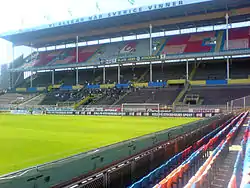 | |
| Malmö | Norrköping | |
| Malmö Stadion | Idrottsparken | |
| Capacity: 30,000 | Capacity: 23,000 | |
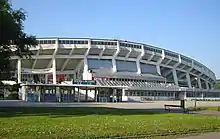 |
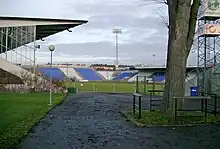 |
Squads
Each national team had to submit a squad of 20 players.
Match ball
Adidas Etrusco Unico was used as the official match ball of the tournament. The ball was previously used in the 1990 FIFA World Cup.
Match officials
| Country | Fourth officials |
|---|---|
| Gerhard Kapl | |
| Frans van den Wijngaert | |
| Vadim Zhuk | |
| Kim Milton Nielsen | |
| Rémi Harrel | |
| Karl-Josef Assenmacher | |
| Sándor Varga | |
| Mario van der Ende | |
| Jorge Emanuel Monteiro Coroado | |
| Leif Sundell |
Group stage
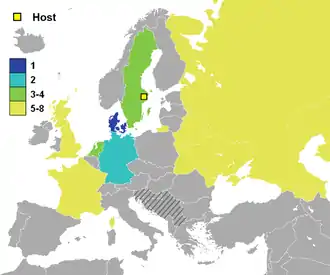
The teams finishing in the top two positions in each of the two groups progress to the semi-finals, while the bottom two teams in each group were eliminated from the tournament.
All times are local, CEST (UTC+2).
Tiebreakers
If two or more teams finished level on points after completion of the group matches, the following tie-breakers were used to determine the final ranking:
- Goal difference in all group matches
- Greater number of goals scored in all group matches
- Drawing of lots
Group 1
| Pos | Team | Pld | W | D | L | GF | GA | GD | Pts | Qualification |
|---|---|---|---|---|---|---|---|---|---|---|
| 1 | 3 | 2 | 1 | 0 | 4 | 2 | +2 | 5 | Advance to knockout stage | |
| 2 | 3 | 1 | 1 | 1 | 2 | 2 | 0 | 3 | ||
| 3 | 3 | 0 | 2 | 1 | 2 | 3 | −1 | 2 | ||
| 4 | 3 | 0 | 2 | 1 | 1 | 2 | −1 | 2 |
Group 2
| Pos | Team | Pld | W | D | L | GF | GA | GD | Pts | Qualification |
|---|---|---|---|---|---|---|---|---|---|---|
| 1 | 3 | 2 | 1 | 0 | 4 | 1 | +3 | 5 | Advance to knockout stage | |
| 2 | 3 | 1 | 1 | 1 | 4 | 4 | 0 | 3 | ||
| 3 | 3 | 1 | 0 | 2 | 3 | 3 | 0 | 2 | ||
| 4 | 3 | 0 | 2 | 1 | 1 | 4 | −3 | 2 |
Knockout stage
In the knockout phase, extra time and a penalty shoot-out were used to decide the winner if necessary. As with every tournament since UEFA Euro 1984, there was no third place play-off.
All times are local, CEST (UTC+2).
Bracket
| Semi-finals | Final | |||||
| 22 June – Gothenburg | ||||||
| 2 (4) | ||||||
| 26 June – Gothenburg | ||||||
| 2 (5) | ||||||
| 2 | ||||||
| 21 June – Solna | ||||||
| 0 | ||||||
| 2 | ||||||
| 3 | ||||||
Semi-finals
Final
Statistics
Goalscorers
There were 32 goals scored in 15 matches, for an average of 2.13 goals per match.
3 goals
2 goals
1 goal
Source: UEFA[14]
Awards
- UEFA Team of the Tournament[15]
| Goalkeeper | Defenders | Midfielders | Forwards |
|---|---|---|---|
Marketing
Slogan and theme song
Small is Beautiful was the official slogan of the contest.[5] The official anthem of the tournament was "More Than a Game", performed by Towe Jaarnek and Peter Jöback.
Logo and identity
It was the last tournament to use the UEFA plus flag logo, and before the tournament was known as "Euro" (it is known as "Euro 1992" only retrospectively). It was also the first major football competition in which the players had their names printed on their backs, around the time that it was becoming a trend in club football across Europe.
Mascot
The official mascot of the competition was a rabbit named Rabbit, dressed in a Swedish football jersey, as well as wearing head and wristbands while playing with a ball.[16]
Sponsorship
| Global sponsors | Event sponsors | |
|---|---|---|
| Sweden | ||
References
- ↑ Chowdhury, Saj (12 May 2012). "Euro 1992: Denmark's fairytale". BBC Sport. British Broadcasting Corporation. Retrieved 11 June 2012.
- 1 2 "Sweden to host 1992 Euro finals". New Straits Times. Reuters. 18 December 1988. Retrieved 16 September 2014.
- ↑ Dietrich Schulze-Marmeling: Die Geschichte der Fußball-Europameisterschaft, Verlag Die Werkstatt, ISBN 978-3-89533-553-2
- ↑ Hughes, Rob (16 October 1991). "Now, the going gets tough". The New York Times. Retrieved 16 September 2014.
- 1 2 Hughes, Rob (10 June 1992). "Confidence and flair: Dutch favored in Euro 92". The New York Times. Retrieved 16 September 2014.
- ↑ "Yugoslav athletes banned". The New York Times. 1 June 1992. Retrieved 16 September 2014.
- ↑ Thomsen, Ian (23 June 1992). "Danes upset Dutch in penalty shoot-out, advance to final". The New York Times. Retrieved 16 September 2014.
- ↑ Thomsen, Ian (27 June 1992). "Upstart Danes upend Germany, 2–0, in soccer final". The New York Times. Retrieved 16 September 2014.
- 1 2 "United Nations Security Council Resolution 757 (Implementing Trade Embargo on Yugoslavia)". UMN.edu. United Nations. 30 May 1992. Retrieved 18 August 2008.
- ↑ "Duitsland speelt met Luxemburg" [Germany plays with Luxembourg]. Provinciale Zeeuwse Courant (in Dutch). Zeeland. 19 December 1991. Retrieved 3 July 2021.
- ↑ "Liedholm verricht loting" [Liedholm conducts draw]. Provinciale Zeeuwse Courant (in Dutch). Zeeland. 13 January 1992. Retrieved 3 July 2021.
- ↑ "Nederland weer tegen Duitsland" [Netherlands again against Germany]. Provinciale Zeeuwse Courant (in Dutch). Zeeland. 18 January 1992. Retrieved 3 July 2021.
- ↑ "European Football Championship 1992 FINAL". euro2000.org. Union of European Football Associations. Archived from the original on 17 August 2000. Retrieved 26 December 2017.
- ↑ "Season 1992 | UEFA EURO | UEFA.com". Union of European Football Associations. Retrieved 14 May 2020.
- ↑ "1992 team of the tournament". Union of European Football Associations. 17 October 2011. Retrieved 17 June 2012.
- ↑ Kell, Tom (1 February 2013). "The weird and wonderful world of Euro mascots". UEFA.com. Union of European Football Associations. Retrieved 5 April 2015.
External links
- UEFA Euro 1992 at UEFA.com
